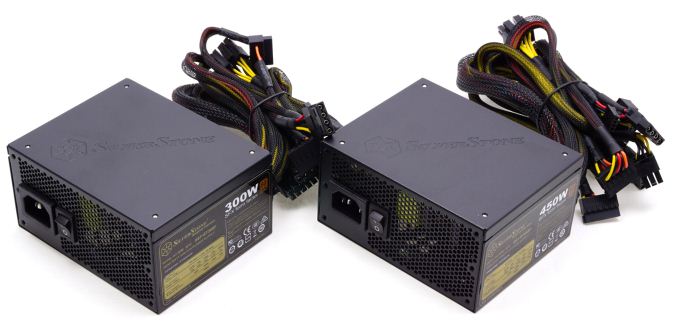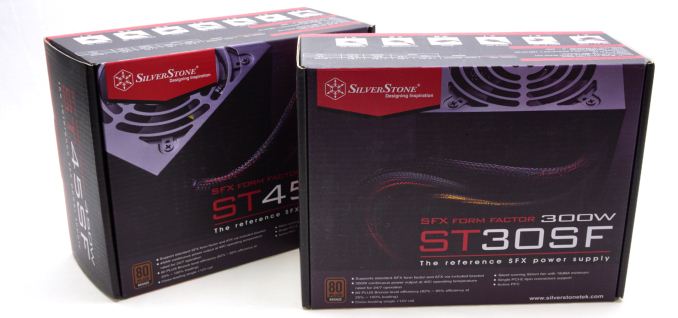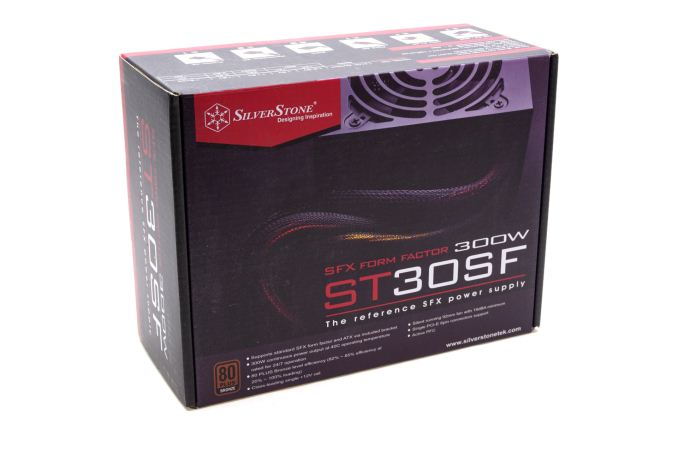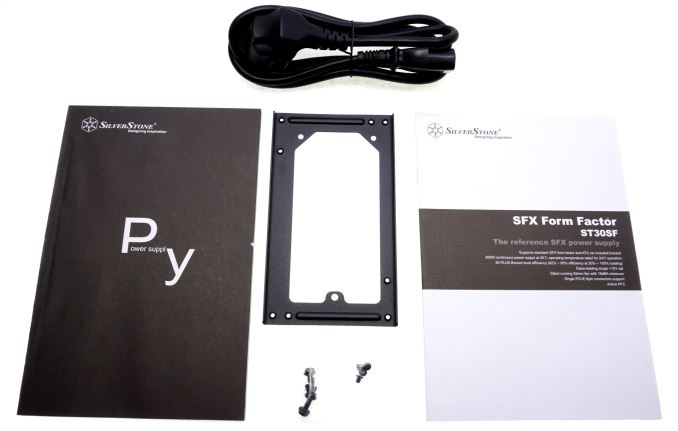The Silverstone ST30SF & ST45SF SFX Power Supply Review
by E. Fylladitakis on January 26, 2017 9:00 AM EST- Posted in
- Cases/Cooling/PSUs
- PSUs
- 80Plus Bronze
- SilverStone
- SFX
- ST30SF
- ST45SF

With the vast selection of advanced ATX PSUs available today, PC users can easily pick one that perfectly suits their budget and needs. When shopping for an SFX PSU however, the options are very limited, as very few companies do market advanced high quality SFX PSUs. Even when the company has a few SFX units available, most of the time these are expensive top-tier models, leaving budget-driven users bewildered.
One of the companies that invests a lot on small form factor systems is SilverStone. The company currently markets dozens of proprietary PC cases, many of which require SFX PSUs. SilverStone is also marketing some of the most advanced SFX PSUs available, such as the 700W SX700-LPT that we reviewed a few months ago and their newly released 800W SX800-LTI with 80Plus Titanium compliance. Outrageously powerful (and expensive) SFX PSUs are not useful to users that want to build simple, compact media or office PCs. Their “SFX extended” form factors make them incompatible with very compact case designs anyway, including many of SilverStone’s own products.
Today we are having a look at the two SFX units that SilverStone is offering for budget-conscious builders, the ST30SF and the ST45SF. Although they are not as grand as the top-tier PSUs we mentioned before, they do have a high power output of 300W and 450W respectively, sufficient for typical media and gaming PCs. They only have an 80Plus Bronze efficiency certification, but what they lack in technology they make up for in price. We should clarify that the units in this review are the latest version, V2.0 for the ST30SF and the V3.0 for the ST45SF, that have been reengineered for improved performance in home and gaming PCs. Most of the differences over their previous versions will be highlighted in the following pages, but the first difference that we should point out is that the new units are rated at 40°C ambient temperature, whereas the previous versions were rated at 50°C.
| SilverStone ST30SF Power specifications ( Rated @ 40 °C ) | |||||
| AC INPUT | 100 - 240 VAC, 50 - 60 Hz | ||||
| RAIL | +3.3V | +5V | +12V | +5Vsb | -12V |
| MAX OUTPUT | 16A | 16A | 25A | 3A | 0.3A |
| 90W | 300W | 15W | 3.6W | ||
| TOTAL | 300W | ||||
| SilverStone ST45SF Power specifications ( Rated @ 40 °C ) | |||||
| AC INPUT | 100 - 240 VAC, 50 - 60 Hz | ||||
| RAIL | +3.3V | +5V | +12V | +5Vsb | -12V |
| MAX OUTPUT | 20A | 20A | 37.5A | 3A | 0.3A |
| 110W | 450W | 15W | 3.6W | ||
| TOTAL | 450W | ||||
Packaging & Bundle
SilverStone supplies their cost-effective SFX PSUs in aesthetically simple, practical cardboard boxes. The artwork on the black boxes is minimal, but SilverStone had every worthwhile bit of information printed on them and they should provide ample shipping protection to the lightweight units.
We expected to find only the absolute minimum of items bundled alongside such units but SilverStone had us surprised. Except from the thorough manual, black mounting screws and the necessary AC cable, the company also supplies an ATX to SFX adapter frame, allowing these SFX units to be installed into ATX compatible cases. This greatly enhances the value of the units, ensuring that they may fit into other cases into the future, as well as their potential market group, as they may be appealing to modders and other people that wish to save some space in their PSU compartment for some reason.
| Connector type | SilverStone ST30SF | SilverStone ST45SF |
| ATX 24 Pin | 1 | 1 |
| EPS 4+4 Pin | 1 | 1 |
| EPS 8 Pin | - | - |
| PCI-E 6+2 Pin | - | 1 |
| PCI-E 6 Pin | 1 | 1 |
| SATA | 3 | 3 |
| Molex | 2 | 2 |
| Floppy | 1 | 1 |













30 Comments
View All Comments
jabber - Thursday, January 26, 2017 - link
PSU is a key component. Plus if you buy a quality one, it may well be the only part that carries over to the next build.Achaios - Wednesday, February 1, 2017 - link
Speaking of it, the only component that has carried itself over to my present build from my first 2008 gaming PC build, is the DVD-ROM drive. It comes very handy with games such as GTAV and the 6 DVD's that came with it.I admit though that if I knew what I know now about PC's, it is possible that I would have kept the original Cooler Master PSU that came with my Cooler Master case, provided that it wouldn't have failed.
Samus - Thursday, January 26, 2017 - link
I personally love PSU reviews. It's interesting to see where corners can be cut to shave costs, and how different manufactures market and how OEM's approach different designs.jabber - Friday, January 27, 2017 - link
I think on my 5820K build back in May I spent more time looking up the PSU than any other part.Samus - Saturday, January 28, 2017 - link
I believe it. I've had a PC Power and Cooling 750 Quad since 2008 go through a PC I kept for 3 years, a mining rig, and now back to a SLI gaming pc. It has had an incredibly hard life being run at 90% load 24/7 on the mining rig for almost 4 year so non-stop, and now it's driving a Xeon workstation with two 980's...It's quiet, has been reliable, and it wasn't even that expensive ($120?) it's 80 Plus but I don't know what tier.
PSU is something everyone should pay attention too. A crappy one could actually result in an unstable PC, especially under load, and a quality one will save money over the long run.
ZipFreed - Tuesday, January 31, 2017 - link
This, so much this. I've seen so many builds over the years both from friends in RL and all over the web with high-end parts and absolutely garbage PSU choices. If you're going to spend $500+ on a CPU you can absolutely afford the +$50 necessary for a quality PSU.I was finally able to build my own rig when I was about 10 years old after always using hand me down parts. I did a ton of research and a quality PSU was something I consistently saw mentioned. Used PCP&C Silencer and have continued to use high-quality PSU's and am currently pushing 30. In that time I've never had a single PSU related failure and have peace of mind knowing my hardware is covered if something happens.
I've been using mainly Seasonic the past 5-6+ years and generally re-use both my PSU, Case and Watercooling loop with 2-3+ different CPU/GPU/Mobo combos before refreshing everything every 18-24 months and repurposing the old stuff. First SS unit is almost 8 years old and it's ran a heavily overclocked system from day 1 and never skipped a beat and is still going strong.
PSU is the lifeblood of your machine, why skimp out?
just4U - Tuesday, January 31, 2017 - link
many on this site likely care simply because they build their own PCs and build for others... I always pay particular interest to which oem is making the unit..and what the reviewers thoughts are on the overall quality.caten - Wednesday, February 1, 2017 - link
I care. +1 for PSU reviews, especially for the more mainstream wattage sizes. I have a mITX system so another +1 for SFX.NZLion - Thursday, January 26, 2017 - link
These seem like very low wattages for modern power supplies. Is my perspective skewed? Is this likely sufficient for the sort of system that would normally use a PSU in the SFX formfactor?For reference, I have a system that uses an SFX PSU, but I went for a 600W unit and even that I felt was a worryingly small margin over the requirements of my system.
flgt - Thursday, January 26, 2017 - link
I would have thought most SFX power supplies are used in small, lower performance machines. Also most likely integrated graphics. So I'm thinking average system power demands of around 100W. As other posters have noted, it's not a good idea to install oversized power supplies as the increased static power kills efficiency at light loads.